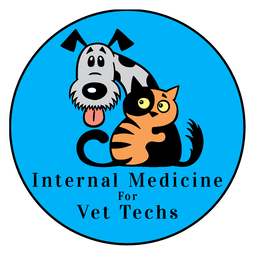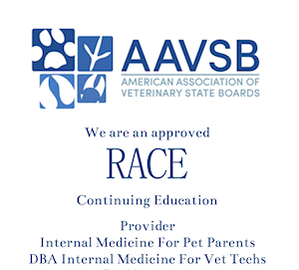|
This week we discuss excess endocrine function, active adrenal glands, "plugged" pituitary gland.... get it? We are talking about hyperadrenocorticism!!!!
Show Notes:
Join Yvonne Brandenburg, RVT, VTS SAIM and Jordan Porter RVT, LVT, VTS SAIM as we talk about:
Resources We Mentioned in the Show
Listening Options
Thanks for listening! – Yvonne and Jordan Continuing Education Certificate
Want to earn some RACE approved CE credits for listening to the podcast? You can earn between 0.5-1.0 hour of RACE approved CE credit for each podcast episode you listen to.
Join the Internal Medicine For Vet Techs Membership to earn and keep track of your continuing education hours as you get your learn on! Join now! http://internalmedicineforvettechsmembership.com/ 009 Cushing's: Hyper Adrenals and Pot Bellies transcript powered by Sonix—the best audio to text transcription service009 Cushing's: Hyper Adrenals and Pot Bellies was automatically transcribed by Sonix with the latest audio-to-text algorithms. This transcript may contain errors. Sonix is the best way to convert your audio to text in 2019. Yvonne Brandenburg, RVT, VTS SAIM: Jordan Porter, RVT, LVT, VTS SAIM: Yvonne Brandenburg, RVT, VTS SAIM: Jordan Porter, RVT, LVT, VTS SAIM: Yvonne Brandenburg, RVT, VTS SAIM: Jordan Porter, RVT, LVT, VTS SAIM: Yvonne Brandenburg, RVT, VTS SAIM: Jordan Porter, RVT, LVT, VTS SAIM: Yvonne Brandenburg, RVT, VTS SAIM: Jordan Porter, RVT, LVT, VTS SAIM: Yvonne Brandenburg, RVT, VTS SAIM: Jordan Porter, RVT, LVT, VTS SAIM: Yvonne Brandenburg, RVT, VTS SAIM: Jordan Porter, RVT, LVT, VTS SAIM: Yvonne Brandenburg, RVT, VTS SAIM: Jordan Porter, RVT, LVT, VTS SAIM: Yvonne Brandenburg, RVT, VTS SAIM: Jordan Porter, RVT, LVT, VTS SAIM: Yvonne Brandenburg, RVT, VTS SAIM: Jordan Porter, RVT, LVT, VTS SAIM: Yvonne Brandenburg, RVT, VTS SAIM: Jordan Porter, RVT, LVT, VTS SAIM: Yvonne Brandenburg, RVT, VTS SAIM: Jordan Porter, RVT, LVT, VTS SAIM: Yvonne Brandenburg, RVT, VTS SAIM: Jordan Porter, RVT, LVT, VTS SAIM: Yvonne Brandenburg, RVT, VTS SAIM: Jordan Porter, RVT, LVT, VTS SAIM: Yvonne Brandenburg, RVT, VTS SAIM: Jordan Porter, RVT, LVT, VTS SAIM: Yvonne Brandenburg, RVT, VTS SAIM: Jordan Porter, RVT, LVT, VTS SAIM: Yvonne Brandenburg, RVT, VTS SAIM: Jordan Porter, RVT, LVT, VTS SAIM: Yvonne Brandenburg, RVT, VTS SAIM: Jordan Porter, RVT, LVT, VTS SAIM: Yvonne Brandenburg, RVT, VTS SAIM: Jordan Porter, RVT, LVT, VTS SAIM: Yvonne Brandenburg, RVT, VTS SAIM: Jordan Porter, RVT, LVT, VTS SAIM: Yvonne Brandenburg, RVT, VTS SAIM: Jordan Porter, RVT, LVT, VTS SAIM: Yvonne Brandenburg, RVT, VTS SAIM: Jordan Porter, RVT, LVT, VTS SAIM: Yvonne Brandenburg, RVT, VTS SAIM: Jordan Porter, RVT, LVT, VTS SAIM: Yvonne Brandenburg, RVT, VTS SAIM: Jordan Porter, RVT, LVT, VTS SAIM: Yvonne Brandenburg, RVT, VTS SAIM: Jordan Porter, RVT, LVT, VTS SAIM: Yvonne Brandenburg, RVT, VTS SAIM: Jordan Porter, RVT, LVT, VTS SAIM: Yvonne Brandenburg, RVT, VTS SAIM: Jordan Porter, RVT, LVT, VTS SAIM: Yvonne Brandenburg, RVT, VTS SAIM: Jordan Porter, RVT, LVT, VTS SAIM: Yvonne Brandenburg, RVT, VTS SAIM: Jordan Porter, RVT, LVT, VTS SAIM: Yvonne Brandenburg, RVT, VTS SAIM: Jordan Porter, RVT, LVT, VTS SAIM: Yvonne Brandenburg, RVT, VTS SAIM: Jordan Porter, RVT, LVT, VTS SAIM: Yvonne Brandenburg, RVT, VTS SAIM: Jordan Porter, RVT, LVT, VTS SAIM: Yvonne Brandenburg, RVT, VTS SAIM: Jordan Porter, RVT, LVT, VTS SAIM: Yvonne Brandenburg, RVT, VTS SAIM: Jordan Porter, RVT, LVT, VTS SAIM: Yvonne Brandenburg, RVT, VTS SAIM: Jordan Porter, RVT, LVT, VTS SAIM: Yvonne Brandenburg, RVT, VTS SAIM: Jordan Porter, RVT, LVT, VTS SAIM: Yvonne Brandenburg, RVT, VTS SAIM: Jordan Porter, RVT, LVT, VTS SAIM: Yvonne Brandenburg, RVT, VTS SAIM: Jordan Porter, RVT, LVT, VTS SAIM: Yvonne Brandenburg, RVT, VTS SAIM: Jordan Porter, RVT, LVT, VTS SAIM: Yvonne Brandenburg, RVT, VTS SAIM: Jordan Porter, RVT, LVT, VTS SAIM: Yvonne Brandenburg, RVT, VTS SAIM: Jordan Porter, RVT, LVT, VTS SAIM: Yvonne Brandenburg, RVT, VTS SAIM: Jordan Porter, RVT, LVT, VTS SAIM: Yvonne Brandenburg, RVT, VTS SAIM: Jordan Porter, RVT, LVT, VTS SAIM: Yvonne Brandenburg, RVT, VTS SAIM: Jordan Porter, RVT, LVT, VTS SAIM: Yvonne Brandenburg, RVT, VTS SAIM: Jordan Porter, RVT, LVT, VTS SAIM: Yvonne Brandenburg, RVT, VTS SAIM: Jordan Porter, RVT, LVT, VTS SAIM: Yvonne Brandenburg, RVT, VTS SAIM: Jordan Porter, RVT, LVT, VTS SAIM: Yvonne Brandenburg, RVT, VTS SAIM: Jordan Porter, RVT, LVT, VTS SAIM: Yvonne Brandenburg, RVT, VTS SAIM: Yvonne Brandenburg, RVT, VTS SAIM: Yvonne Brandenburg, RVT, VTS SAIM: Jordan Porter, RVT, LVT, VTS SAIM: Yvonne Brandenburg, RVT, VTS SAIM: Jordan Porter, RVT, LVT, VTS SAIM: Yvonne Brandenburg, RVT, VTS SAIM: Jordan Porter, RVT, LVT, VTS SAIM: Yvonne Brandenburg, RVT, VTS SAIM: Jordan Porter, RVT, LVT, VTS SAIM: Yvonne Brandenburg, RVT, VTS SAIM: Jordan Porter, RVT, LVT, VTS SAIM: Yvonne Brandenburg, RVT, VTS SAIM: Jordan Porter, RVT, LVT, VTS SAIM: Yvonne Brandenburg, RVT, VTS SAIM: Jordan Porter, RVT, LVT, VTS SAIM: Jordan Porter, RVT, LVT, VTS SAIM: Yvonne Brandenburg, RVT, VTS SAIM: Jordan Porter, RVT, LVT, VTS SAIM: Yvonne Brandenburg, RVT, VTS SAIM: Jordan Porter, RVT, LVT, VTS SAIM: Yvonne Brandenburg, RVT, VTS SAIM: Jordan Porter, RVT, LVT, VTS SAIM: Yvonne Brandenburg, RVT, VTS SAIM: Exactly. And I think too it can be scary, especially if you have the elevated ALT, where you're like, "oh no." Like, you know, just instantly worried that something more might be wrong with the liver. Yvonne Brandenburg, RVT, VTS SAIM: Jordan Porter, RVT, LVT, VTS SAIM: Yvonne Brandenburg, RVT, VTS SAIM: Jordan Porter, RVT, LVT, VTS SAIM: Yvonne Brandenburg, RVT, VTS SAIM: Jordan Porter, RVT, LVT, VTS SAIM: Jordan Porter, RVT, LVT, VTS SAIM: Yvonne Brandenburg, RVT, VTS SAIM: Jordan Porter, RVT, LVT, VTS SAIM: Yvonne Brandenburg, RVT, VTS SAIM: Jordan Porter, RVT, LVT, VTS SAIM: Yvonne Brandenburg, RVT, VTS SAIM: Jordan Porter, RVT, LVT, VTS SAIM: Yvonne Brandenburg, RVT, VTS SAIM: Jordan Porter, RVT, LVT, VTS SAIM: Yvonne Brandenburg, RVT, VTS SAIM: Jordan Porter, RVT, LVT, VTS SAIM: Yvonne Brandenburg, RVT, VTS SAIM: Jordan Porter, RVT, LVT, VTS SAIM: Yvonne Brandenburg, RVT, VTS SAIM: And then actually to kind of go along with that. So, it used to be, for Cosyntropin, and some people do this still, is it was one bottle of Cosyntropin per patient. Jordan Porter, RVT, LVT, VTS SAIM: Yvonne Brandenburg, RVT, VTS SAIM: Jordan Porter, RVT, LVT, VTS SAIM: Yvonne Brandenburg, RVT, VTS SAIM: Jordan Porter, RVT, LVT, VTS SAIM: Yvonne Brandenburg, RVT, VTS SAIM: Jordan Porter, RVT, LVT, VTS SAIM: Yvonne Brandenburg, RVT, VTS SAIM: Jordan Porter, RVT, LVT, VTS SAIM: Yvonne Brandenburg, RVT, VTS SAIM: Jordan Porter, RVT, LVT, VTS SAIM: Yvonne Brandenburg, RVT, VTS SAIM: Jordan Porter, RVT, LVT, VTS SAIM: Yvonne Brandenburg, RVT, VTS SAIM: Jordan Porter, RVT, LVT, VTS SAIM: Yvonne Brandenburg, RVT, VTS SAIM: Jordan Porter, RVT, LVT, VTS SAIM: Yvonne Brandenburg, RVT, VTS SAIM: Jordan Porter, RVT, LVT, VTS SAIM: Yvonne Brandenburg, RVT, VTS SAIM: Jordan Porter, RVT, LVT, VTS SAIM: Yvonne Brandenburg, RVT, VTS SAIM: Jordan Porter, RVT, LVT, VTS SAIM: Yvonne Brandenburg, RVT, VTS SAIM: Yeah. Yvonne Brandenburg, RVT, VTS SAIM: Jordan Porter, RVT, LVT, VTS SAIM: Yvonne Brandenburg, RVT, VTS SAIM: Jordan Porter, RVT, LVT, VTS SAIM: Yvonne Brandenburg, RVT, VTS SAIM: Jordan Porter, RVT, LVT, VTS SAIM: Yvonne Brandenburg, RVT, VTS SAIM: Jordan Porter, RVT, LVT, VTS SAIM: Yvonne Brandenburg, RVT, VTS SAIM: Yvonne Brandenburg, RVT, VTS SAIM: Jordan Porter, RVT, LVT, VTS SAIM: Yvonne Brandenburg, RVT, VTS SAIM: Jordan Porter, RVT, LVT, VTS SAIM: Yvonne Brandenburg, RVT, VTS SAIM: Jordan Porter, RVT, LVT, VTS SAIM: Yvonne Brandenburg, RVT, VTS SAIM: Jordan Porter, RVT, LVT, VTS SAIM: Yvonne Brandenburg, RVT, VTS SAIM: Jordan Porter, RVT, LVT, VTS SAIM: Yvonne Brandenburg, RVT, VTS SAIM: Jordan Porter, RVT, LVT, VTS SAIM: Yvonne Brandenburg, RVT, VTS SAIM: Jordan Porter, RVT, LVT, VTS SAIM: Yvonne Brandenburg, RVT, VTS SAIM: Jordan Porter, RVT, LVT, VTS SAIM: Yvonne Brandenburg, RVT, VTS SAIM: Jordan Porter, RVT, LVT, VTS SAIM: Yvonne Brandenburg, RVT, VTS SAIM: Jordan Porter, RVT, LVT, VTS SAIM: Yvonne Brandenburg, RVT, VTS SAIM: Jordan Porter, RVT, LVT, VTS SAIM: Yvonne Brandenburg, RVT, VTS SAIM: Jordan Porter, RVT, LVT, VTS SAIM: Yvonne Brandenburg, RVT, VTS SAIM: Jordan Porter, RVT, LVT, VTS SAIM: Yvonne Brandenburg, RVT, VTS SAIM: Jordan Porter, RVT, LVT, VTS SAIM: Yvonne Brandenburg, RVT, VTS SAIM: Jordan Porter, RVT, LVT, VTS SAIM: Yvonne Brandenburg, RVT, VTS SAIM: Jordan Porter, RVT, LVT, VTS SAIM: Yvonne Brandenburg, RVT, VTS SAIM: Jordan Porter, RVT, LVT, VTS SAIM: Yvonne Brandenburg, RVT, VTS SAIM: Jordan Porter, RVT, LVT, VTS SAIM: Yvonne Brandenburg, RVT, VTS SAIM: Jordan Porter, RVT, LVT, VTS SAIM: Yvonne Brandenburg, RVT, VTS SAIM: Jordan Porter, RVT, LVT, VTS SAIM: Yvonne Brandenburg, RVT, VTS SAIM: Jordan Porter, RVT, LVT, VTS SAIM: Yvonne Brandenburg, RVT, VTS SAIM: Jordan Porter, RVT, LVT, VTS SAIM: Yvonne Brandenburg, RVT, VTS SAIM: Jordan Porter, RVT, LVT, VTS SAIM: Yvonne Brandenburg, RVT, VTS SAIM: Jordan Porter, RVT, LVT, VTS SAIM: Yvonne Brandenburg, RVT, VTS SAIM: Jordan Porter, RVT, LVT, VTS SAIM: Yvonne Brandenburg, RVT, VTS SAIM: Jordan Porter, RVT, LVT, VTS SAIM: Yvonne Brandenburg, RVT, VTS SAIM: Jordan Porter, RVT, LVT, VTS SAIM: Yvonne Brandenburg, RVT, VTS SAIM: Jordan Porter, RVT, LVT, VTS SAIM: Yvonne Brandenburg, RVT, VTS SAIM: Jordan Porter, RVT, LVT, VTS SAIM: Yvonne Brandenburg, RVT, VTS SAIM: Jordan Porter, RVT, LVT, VTS SAIM: Yvonne Brandenburg, RVT, VTS SAIM: Jordan Porter, RVT, LVT, VTS SAIM: Yvonne Brandenburg, RVT, VTS SAIM: Jordan Porter, RVT, LVT, VTS SAIM: Yvonne Brandenburg, RVT, VTS SAIM: Jordan Porter, RVT, LVT, VTS SAIM: Yvonne Brandenburg, RVT, VTS SAIM: Jordan Porter, RVT, LVT, VTS SAIM: Yvonne Brandenburg, RVT, VTS SAIM: Jordan Porter, RVT, LVT, VTS SAIM: Yvonne Brandenburg, RVT, VTS SAIM: Jordan Porter, RVT, LVT, VTS SAIM: Yvonne Brandenburg, RVT, VTS SAIM: Jordan Porter, RVT, LVT, VTS SAIM: Yvonne Brandenburg, RVT, VTS SAIM: Jordan Porter, RVT, LVT, VTS SAIM: Yvonne Brandenburg, RVT, VTS SAIM: Yvonne Brandenburg, RVT, VTS SAIM: Jordan Porter, RVT, LVT, VTS SAIM: Yvonne Brandenburg, RVT, VTS SAIM: Jordan Porter, RVT, LVT, VTS SAIM: Yvonne Brandenburg, RVT, VTS SAIM: Jordan Porter, RVT, LVT, VTS SAIM: Yvonne Brandenburg, RVT, VTS SAIM: Jordan Porter, RVT, LVT, VTS SAIM: Yvonne Brandenburg, RVT, VTS SAIM: Jordan Porter, RVT, LVT, VTS SAIM: Yvonne Brandenburg, RVT, VTS SAIM: Jordan Porter, RVT, LVT, VTS SAIM: Yvonne Brandenburg, RVT, VTS SAIM: Jordan Porter, RVT, LVT, VTS SAIM: Jordan Porter, RVT, LVT, VTS SAIM: Jordan Porter, RVT, LVT, VTS SAIM: Yvonne Brandenburg, RVT, VTS SAIM: Jordan Porter, RVT, LVT, VTS SAIM: Yvonne Brandenburg, RVT, VTS SAIM: Jordan Porter, RVT, LVT, VTS SAIM: Yvonne Brandenburg, RVT, VTS SAIM: Jordan Porter, RVT, LVT, VTS SAIM: Yvonne Brandenburg, RVT, VTS SAIM: Jordan Porter, RVT, LVT, VTS SAIM: Yvonne Brandenburg, RVT, VTS SAIM: Jordan Porter, RVT, LVT, VTS SAIM: Yvonne Brandenburg, RVT, VTS SAIM: Jordan Porter, RVT, LVT, VTS SAIM: Yvonne Brandenburg, RVT, VTS SAIM: Jordan Porter, RVT, LVT, VTS SAIM: Yvonne Brandenburg, RVT, VTS SAIM: Jordan Porter, RVT, LVT, VTS SAIM: Yvonne Brandenburg, RVT, VTS SAIM: Jordan Porter, RVT, LVT, VTS SAIM: Yvonne Brandenburg, RVT, VTS SAIM: Jordan Porter, RVT, LVT, VTS SAIM: Yvonne Brandenburg, RVT, VTS SAIM: Jordan Porter, RVT, LVT, VTS SAIM: Yvonne Brandenburg, RVT, VTS SAIM: Jordan Porter, RVT, LVT, VTS SAIM: Yvonne Brandenburg, RVT, VTS SAIM: Thank you for listening to today's episode of the Internal Medicine For Vet Techs Podcast. If you like what you heard, we'd love for you to share with someone you think might enjoy the podcast. And make sure to subscribe so you never miss an episode. Want to give us a boost? Please leave a review on i-Tunes or your favorite pod catcher and we'll be sure to say thank you. Find out everything about us at InternalMedicineForVetTechs.com. Talk to you next week. Bye. Quickly and accurately convert audio to text with Sonix.Sonix uses cutting-edge artificial intelligence to convert your mp3 files to text. Thousands of researchers and podcasters use Sonix to automatically transcribe their audio files (*.mp3). Easily convert your mp3 file to text or docx to make your media content more accessible to listeners. Sonix is the best online audio transcription software in 2019—it's fast, easy, and affordable.If you are looking for a great way to convert your mp3 to text, try Sonix today. Question of the Week:
What is your favorite endocrine disorder?
Leave a comment below!
1 Comment
|
Looking for a specific topic? Search below to get the right episode!
Sign Up for your password for the Technician Treasure Trove! Where to ListenArchives
June 2024
Categories
All
|
Visit www.InternalMedicineForPetParents.com to learn more about us

 RSS Feed
RSS Feed

